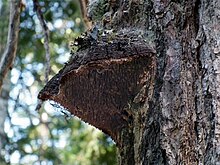
Polypores are a group of fungi that form large fruiting bodies with pores or tubes on the underside. They are a morphological group of basidiomycetes-like gilled mushrooms and hydnoid fungi, and not all polypores are closely related to each other. Polypores are also called bracket fungi or shelf fungi, and they characteristically produce woody, shelf- or bracket-shaped or occasionally circular fruiting bodies that are called conks.
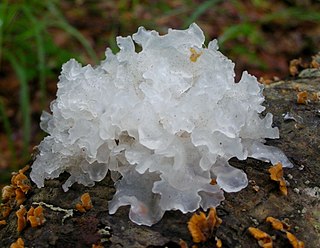
Tremella fuciformis is a species of fungus; it produces white, frond-like, gelatinous basidiocarps. It is widespread, especially in the tropics, where it can be found on the dead branches of broadleaf trees. This fungus is commercially cultivated and is one of the most popular fungi in the cuisine and medicine of China. T. fuciformis is commonly known as snow fungus, snow ear, silver ear fungus, white jelly mushroom, and white cloud ears.

Laricifomes officinalis, also known as agarikon, eburiko, or the quinine conk, is a wood-decay fungus that causes brown heart rot on conifers native to Europe, Asia, and North America, as well as Morocco. This fungus is the only member of the genus Laricifomes, in the order Polyporales. The fruiting bodies grow in large conks on the trunks of trees.

Daedaleopsis confragosa, commonly known as the thin walled maze polypore or the blushing bracket, is a species of polypore fungus in the family Polyporaceae. A plant pathogen, it causes a white rot of injured hardwoods, especially willows. The fruit bodies are semicircular and tough, have a concentrically zoned brownish upper surface, and measure up to 20 cm (8 in) in diameter. The whitish underside turns gray-brown as the fruit body ages, but bruises pink or red. It is found all year and is common in northern temperate woodlands of eastern North America, Europe, and Asia. The species was first described from Europe in 1791 as a form of Boletus, and has undergone several changes of genus in its taxonomic history. It acquired its current name when Joseph Schröter transferred it to Daedaleopsis in 1888.

Hydnellum peckii is a fungus in the genus Hydnellum of the family Bankeraceae. It is a hydnoid species, producing spores on the surface of vertical spines or tooth-like projections that hang from the undersurface of the fruit bodies. It is found in North America, Europe, and was recently discovered in Iran (2008) and Korea (2010). Hydnellum peckii is a mycorrhizal species, and forms mutually beneficial relationships with a variety of coniferous trees, growing on the ground singly, scattered, or in fused masses.

Hydnellum caeruleum, commonly known as the blue-gray hydnellum, blue-green hydnellum, blue spine, blue tooth, or bluish tooth, is an inedible fungus found in North America, Europe, and temperate areas of Asia.

Bridgeoporus is a fungal genus in the family Polyporaceae. A monotypic genus, it contains the single polypore species Bridgeoporus nobilissimus, first described to science in 1949. Commonly known both as the noble polypore and the fuzzy Sandozi, this fungus produces large fruit bodies that have been found to weigh up to 130 kilograms (290 lb). The upper surface of the fruit body has a fuzzy or fibrous texture that often supports the growth of algae, bryophytes, or vascular plants.

Crepidotus versutus, commonly known as the evasive agaric, is a species of fungus in the family Crepidotaceae. It is saprobic on wood, like other Crepidotus species, but it can also decompose herbaceous forest litter. The species is characterized by large, punctate, ellipsoid spores, and the white, hairy pileus.
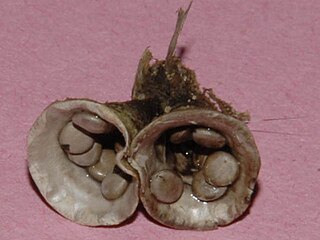
Cyathus olla also known as the field bird's nest is a species of saprobic fungus in the genus Cyathus of the family Nidulariaceae. The fruit bodies resemble tiny bird's nests filled with "eggs" – spore-containing structures called peridioles. Like other bird's nest fungi, C. olla relies on the force of falling water to dislodge peridioles from fruiting bodies to eject and disperse their spores. The life cycle of this fungus allows it to reproduce both sexually, with meiosis, and asexually via spores. C. olla is a relatively common fungus, with a worldwide distribution. It is the subject of agricultural research to determine its potential as a means to accelerate the breakdown of crop residue, and reduce the population of plant pathogens. The specific epithet is derived from the Latin word olla, meaning "pot".

Chorioactis is a genus of fungi that contains the single species Chorioactis geaster. The mushroom is commonly known as the devil's cigar or the Texas star in the United States, while in Japan it is called kirinomitake (キリノミタケ). This extremely rare mushroom is notable for its unusual appearance and disjunct distribution; it is found only in select locales in Texas and Japan. The fruit body, which grows on the stumps or dead roots of cedar elms or dead oaks, somewhat resembles a dark brown or black cigar before it splits open radially into a starlike arrangement of four to seven leathery rays. The interior surface of the fruit body bears the spore-bearing tissue known as the hymenium, and is colored white to brown, depending on its age. The fruit body opening can be accompanied by a distinct hissing sound and the release of a smoky cloud of spores.

Polyozellus is a fungal genus in the family Thelephoraceae, a grouping of mushrooms known collectively as the leathery earthfans. Previously considered a monotypic genus, it now contains the Polyozellus multiplex species complex. The genus name is derived from the Greek poly meaning many, and oz, meaning branch. It is commonly known as the blue chanterelle, the clustered blue chanterelle, or, in Alaska, the black chanterelle. The distinctive fruit body of this species comprises blue- to purple-colored clusters of vase- or spoon-shaped caps with veiny wrinkles on the undersurface that run down the length of the stem.

Polyozellus multiplex is a species complex of fungi first described in 1899. P. multiplex is commonly known as the blue chanterelle, the purple chanterelle, or, in Alaska, the black chanterelle. However, this mushroom is not closely related to true chanterelles. While this name used to refer to a group of species, it is now used to describe only one species that held onto the name P. multiplex. The fruiting bodies of this species are blue- to purple-colored clusters of vase- or spoon-shaped caps, with veiny wrinkles on the underside which run down the length of the stem. P. multiplex was considered the monotypic species of the genus Polyozellus until recent molecular research divided the P. multiplex species complex into five species. The genus name is derived from the Greek poly meaning many, and oz, meaning branch. The specific epithet multiplex means "in many pieces," referring to the compound nature of the fruiting body.

Xerocomellus zelleri, commonly known as Zeller's bolete, is an edible species of mushroom in the family Boletaceae. First described scientifically by American mycologist William Alphonso Murrill in 1912, the species has been juggled by various authors to several genera, including Boletus, Boletellus, and Xerocomus. Found solely in western North America from British Columbia south to Mexico, the fruit bodies are distinguished by their dark reddish brown to nearly black caps with uneven surfaces, the yellow pores on the underside of the caps, and the red-streaked yellow stems. The fungus grows in summer and autumn on the ground, often in Douglas fir forests or on their margins. The development of the fruit bodies is gymnocarpic, meaning that the hymenium appears and develops to maturity in an exposed state, not enclosed by any protective membrane.
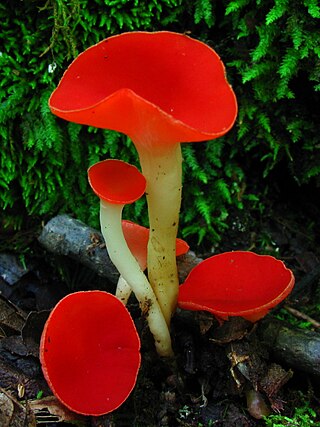
Sarcoscypha occidentalis, commonly known as the stalked scarlet cup or the western scarlet cup, is a species of fungus in the family Sarcoscyphaceae of the Pezizales order. Phylogenetic analysis has shown that it is most closely related to other Sarcoscypha species that contain large oil droplets in their spores. S. occidentalis has an imperfect form, classified as Molliardiomyces occidentalis.
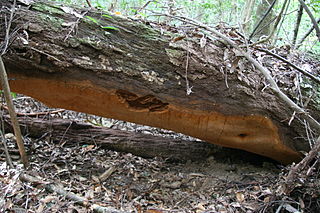
Phellinus ellipsoideus is a species of polypore fungus in the family Hymenochaetaceae, a specimen of which produced the largest fungal fruit body ever recorded. Found in China, the fruit bodies produced by the species are brown, woody basidiocarps that grow on dead wood, where the fungus feeds as a saprotroph. The basidiocarps are perennial, allowing them to grow very large under favourable circumstances. They are resupinate, measuring 30 centimetres (12 in) or more in length, though typically extending less than a centimetre from the surface of the wood. P. ellipsoideus produces distinct ellipsoidal spores, after which it is named, and unusual setae. These two features allow it to be readily differentiated microscopically from other, similar species. Chemical compounds isolated from the species include several steroidal compounds. These may have pharmacological applications, but further research is needed.

Xylobolus frustulatus, commonly known as the ceramic fungus or ceramic parchment, is an inedible species of crust fungus in the Stereaceae family. The fruit body forms small, hard, flat crust-like aggregations that resemble broken pieces of ceramic tile. These pieces are initially whitish before turning yellow-brown to gray-brown in age. The spore-bearing cells cover the upper surfaces of the fruit body. A saprobic species, it grows on well-decayed oak wood in Asia, northern Europe, and North America.

Picipes badius, commonly known as the black-footed polypore or black-leg, is a species of fungus in the family Polyporaceae. It causes a white rot of hardwoods and conifers. The species is found in temperate areas of Asia, Australia, Europe, and North America. It has a dark brown or reddish-brown cap that reaches a diameter of 25 cm (9.8 in), and a stipe that is often completely black or brown at the top and black at the base.

Pycnoporellus alboluteus, commonly known as the orange sponge polypore, is a species of polypore fungus in the family Fomitopsidaceae. Distributed throughout the boreal conifer zone, the fungus is found in mountainous regions of western North America, and in Europe. It causes a brown cubical rot of conifer wood, especially spruce, but also fir and poplar. The soft, spongy orange fruit bodies grow spread out on the surface of fallen logs. Mature specimens have tooth-like or jagged pore edges. A snowbank mushroom, P. alboluteus can often be found growing on logs or stumps protruding through melting snow. Although the edibility of the fungus and its usage for human culinary purposes are unknown, several species of beetles use the fungus as a food source.
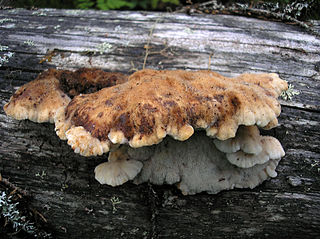
Amylocystis lapponica is a species of bracket fungus in the family Fomitopsidaceae, and the type species of genus Amylocystis. It produces medium-sized, annual fruit bodies that are soft, and have a strong, distinct smell. The fungus is a saprophyte that feeds on coniferous wood of logs lying on the ground, and causes brown rot. It is a rather rare species that only occurs in old-growth forest.

Hypsizygus ulmarius, also known as the elm oyster mushroom, and less commonly as the elm leech, elm Pleurotus, is an edible fungus. It has often been confused with oyster mushrooms in the Pleurotus genus but can be differentiated easily as the gills are either not decurrent or not deeply decurrent. While not quite as common as true oyster mushrooms, they have a wide range globally in temperate forests. The mushrooms and vegetative hyphae of this species have been studied in recent years for their potential benefits to human health, and mycoremediation.

